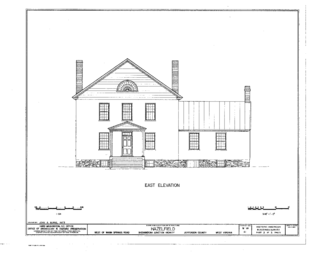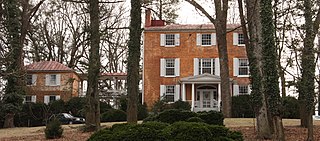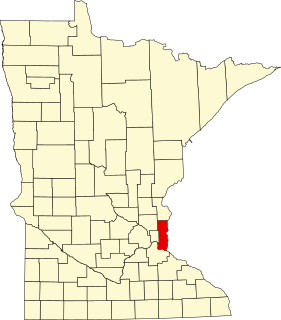
Woodlawn is a historic house located in Fairfax County, Virginia. Originally a part of Mount Vernon, George Washington's historic plantation estate, it was subdivided in the 19th century by abolitionists to demonstrate the viability of a free labor system. The address is now 9000 Richmond Highway, Alexandria, Virginia, but due to expansion of Fort Belvoir and reconstruction of historic Route 1, access is via Woodlawn Road slightly south of Jeff Todd Way/State Route 235. The house is a designated National Historic Landmark, primarily for its association with the Washington family, but also for the role it played in the historic preservation movement. It is now a museum property owned and managed by the National Trust for Historic Preservation.

Lower Brandon Plantation is located on the south shore of the James River in present-day Prince George County, Virginia.

The Shirley–Eustis House is a historic house located at 33 Shirley Street, Boston, Massachusetts. It is a U.S. National Historic Landmark.

This is a complete list of National Register of Historic Places listings in Ramsey County, Minnesota. It is intended to be a complete list of the properties and districts on the National Register of Historic Places in Ramsey County, Minnesota, United States. The locations of National Register properties and districts for which the latitude and longitude coordinates are included below, may be seen in an online map.

Hazelfield, located near Shenandoah Junction, West Virginia is a historic farm, whose principal residence was built in 1815 for Ann Stephen Dandridge Hunter.

Elmwood is a Federal style house near Shepherdstown, West Virginia. Located on land claimed in 1732 by Edward Lucas II, it was built in 1797 by his son, Edward Lucas III. During the Civil War the house was used as a field hospital. It remained in the Lucas family until 1948.

Morgan's Grove is a rural historic district near Shepherdstown, West Virginia. The area is noted for its abundant springs. Several historic houses and farms are in the district, including:

Falling Spring at Morgan's Grove is part of a related complex of buildings and lands associated with the Morgan family and other prominent members of the Shepherdstown, West Virginia, community.
Woodlawn, also known as Wiltshire House or Wiltshire Farm, was built circa 1820, one of four homes within a two-mile radius by James Hurst, a significant landowner in Jefferson County. Hurst built the first three houses for his children on his "LaGrange" plantation around 1811, including "Snow Hill' (now known as the Jefferson County Alms House and the Coyle House. Woodlawn was built for the adopted daughter of Samuel Davenport, whose married name was Camilla Wiltshire. All of these homes used salt-glazed brick, as did Elmwood and the Tate-Fairfax-Muse House.

Rion Hall is a late Federal style house near Halltown, West Virginia. Built in 1836, it consists of a three-story brick house with a two-story kitchen wing connected by a wood hyphen. The house was used as a headquarters for General Philip H. Sheridan during the American Civil War.

Cold Spring is a house near Shepherdstown, West Virginia, childhood home to two United States Representatives. The house was built by Edward Lucas III and his son, Robert in 1793.

This is a list of the National Register of Historic Places listings in Monterey County, California.

This is a list of the National Register of Historic Places listings in Winona County, Minnesota. It is intended to be a complete list of the properties and districts on the National Register of Historic Places in Winona County, Minnesota, United States. The locations of National Register properties and districts for which the latitude and longitude coordinates are included below, may be seen in an online map.

This is a list of the National Register of Historic Places listings in Fillmore County, Minnesota. It is intended to be a complete list of the properties and districts on the National Register of Historic Places in Fillmore County, Minnesota, United States. The locations of National Register properties and districts for which the latitude and longitude coordinates are included below, may be seen in an online map.

This is a list of the National Register of Historic Places listings in Wabasha County, Minnesota. It is intended to be a complete list of the properties and districts on the National Register of Historic Places in Wabasha County, Minnesota, United States. The locations of National Register properties and districts for which the latitude and longitude coordinates are included below, may be seen in an online map.

This is a list of the National Register of Historic Places listings in Washington County, Minnesota. It is intended to be a complete list of the properties and districts on the National Register of Historic Places in Washington County, Minnesota, United States. The locations of National Register properties and districts for which the latitude and longitude coordinates are included below, may be seen in an online map.

This is a list of the National Register of Historic Places listings in Houston County, Minnesota. It is intended to be a complete list of the properties and districts on the National Register of Historic Places in Houston County, Minnesota, United States. The locations of National Register properties and districts for which the latitude and longitude coordinates are included below, may be seen in an online map.
William Beverley (1696–1756) was an 18th-century legislator, civil servant, planter and landowner in the Colony of Virginia. Born in Virginia, Beverley—the son of planter and historian Robert Beverley, Jr. and his wife, Ursula Byrd Beverley (1681–1698)—was the scion of two prominent Virginia families. He was the nephew of Peter Beverley (1668–1728), Speaker of the Virginia House of Burgesses, and the grandson of wealthy Virginia planter William Byrd I (1652–1704) of Westover Plantation. Beverley's mother died shortly before her 17th birthday, and he was sent to England.
Leesylvania was a plantation and historic home in Prince William County, Virginia, now part of Leesylvania State Park. During the 18th century, it was the home of Henry Lee II, his family and numerous enslaved people, and known for its productive land and especially the quality of its tobacco. Lee's sons Henry "Light-Horse Harry" Lee, Richard Bland Lee and Charles Lee, held prominent positions in Virginia during the American Revolutionary War and early federal government.



















